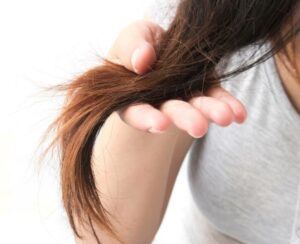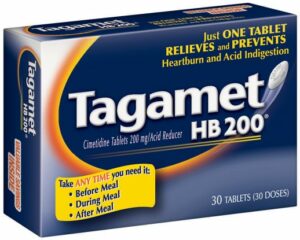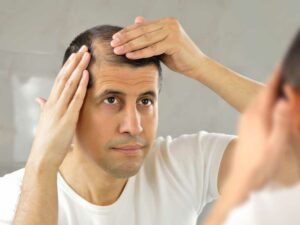Abstract:
Androgenetic alopecia (a.A.) occurs quite frequently. Up to 79% of women suffer at least temporarily from varying degrees of intermittent diffuse hairloss in the centro-parietal and/or fronto-temporal regions. A.A. is caused by an androgen excess acting on the hair follicle for prolonged periods of time in the presence of a genetic predisposition. However, often hyperandrogenemia cannot be demonstrated in such patients. 125 women with clinically typical a.A. were investigated prospectively under standardized conditions. Patient age ranged from 18 to 68 years (mean +/- SD: 34 +/- 11.6). Atypical uterine bleeding such as menorrhagia, hypermenorrhea and polymenorrhea were found in 69 women. The hairloss varied between 50 and 400 hairs per day (124 +/- 125). Additional signs of hyperandrogenism, i.e. seborrhea (n = 83), acne (n = 52) and hirsutism (n = 28), were often observed. Basal levels of total and free testosterone (T and FT), dihydro-T (DHT) DHEA-sulfate (DS), delta 4-androstendione (A), 17 alpha-hydroxy-progesterone (17P), cortisol (F), progesterone (P), 17 beta-estradiol (E2), sex hormone binding globuline (SHBG), prolactin (PRL), thyreoidea-stimulating hormone (TSH), ferritin (Fe), vitamin B12 (B12) and folat (Fo) were determined by RIA. FT was also measured by equilibrium dialyses. Different methods of determining bound and unbound T were used; their diagnostic value is discussed in detail. In addition, a combined ACTH/TRH-stimulation test was performed in all patients. Pathologic changes of one parameter were detectable in 26.4% of patients, while 67.2% revealed deviations of two or more indices. Excluding clinically relevant borderline values, only 6.4% of patients were without any abnormalities. The incidence rate of pathologic parameters was as follows: FT in % = 52%, Fe = 42%, PRL = 34%, E2 = 34%, FT in pg = 29%, DHT = 28%, SHBG = 26%, TSH = 20.8%, DS = 19%, T = 14%, 17P = 11%, Fo = 7%, A = 6%, F = 6%, B12 = 5%. Group and individual case analyses revealed significant correlations between (1) the levels of the various androgens, PRL and TSH and (2) the E2, SHBG and FT values; these, in turn, were correlated to (3) the occurrence of certain bleeding anomalies (amount, duration, interval) and corresponding ferritin deficiency. Therapy was directed at normalizing the disturbed estrogen-androgen-balance. Using low-dose antiandrogens, estrogens, prolactin suppressants, corticoids, iron-II-preparations as well as estrogen-containing hair lotions hairloss was arrested in 74 of 104 treated women, while regrowth of hair was accomplished in 16 patients. 14 women did not respond to therapy.
Author:
Moltz L
Source:
Geburtshilfe Frauenheilkd, 48: 4, 1988 Apr, 203-14
Language:
German
Unique Identifier:
88242972





